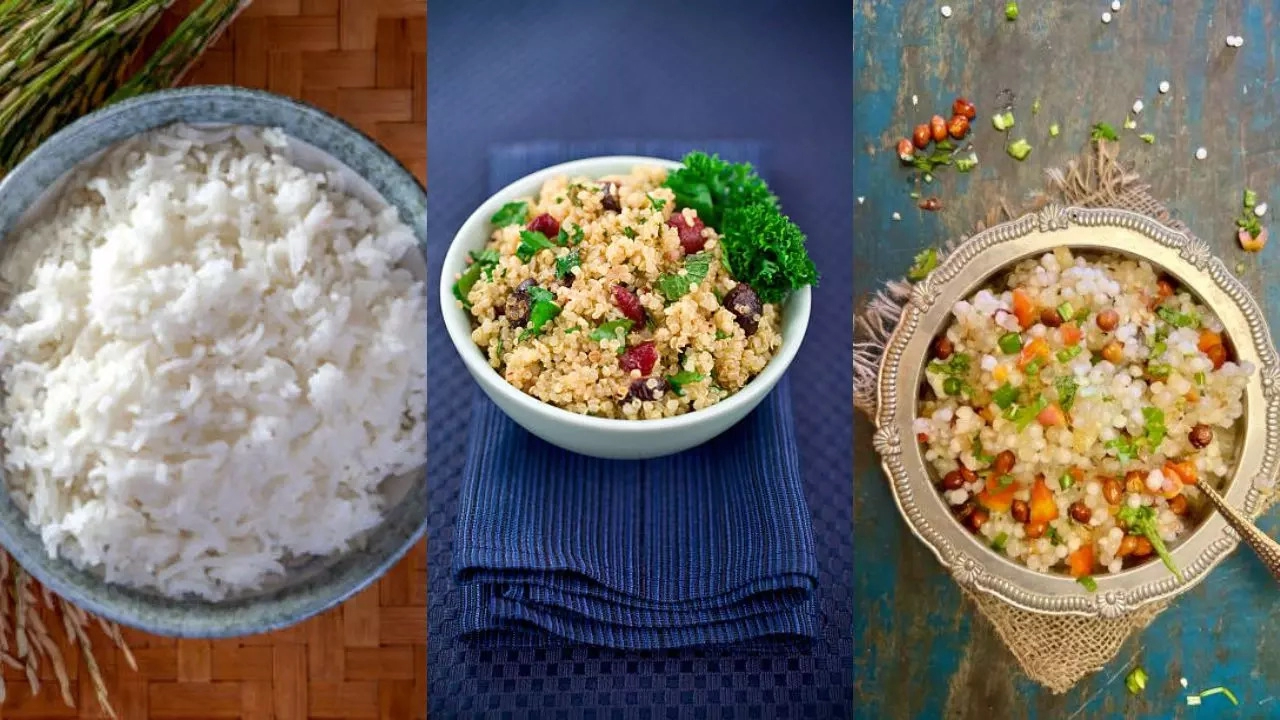Pallavi Mehra • 11 Oct 2024
Samak Rice Vs Quinoa Vs Sabudana: Nutritional Faceoff Of These Popular Navratri Foods

Samak Rice Vs Quinoa Vs Sabudana: Nutritional Faceoff Of These Popular Navratri Foods (Image Credits: iStock)
During Navratri, a significant festival marked by devotion and fasting, traditional grains like wheat and rice are typically avoided. Instead, people turn to alternatives like quinoa, sabudana, and samak rice, all of which fit the fasting guidelines and offer distinct nutritional benefits. But which one has the maximum benefits? We got in touch with Ms Parmeet Kaur, Head and Chief Nutritionist at Marengo Asia Hospital, Gurugram, shares her insights on the health benefits and drawbacks of these grains during fasting.
1. Samak Rice (Barnyard Millet)
Also known as "vrat ke chawal," samak rice is a millet that resembles rice but offers distinct nutritional benefits. It is a popular choice during fasting due to its energy-boosting properties.Nutritional Value:
Per 100 grams of cooked samak rice provides 155 calories, 37 grams of carbohydrates, 3.5 grams of protein, 1.5 grams of fibre, and 0.3 grams of fat. It also contains 2.1 mg of iron and 11 mg of calcium, supporting blood health and bone strength.
Health Advantages:
Rich in Carbohydrates, samak rice is a good source of energy, making it ideal for people fasting and needing sustained energy.
- Low Glycemic Index: With a lower glycemic index than white rice, it helps regulate blood sugar levels, which is especially beneficial during long fasting periods.
- Gluten-Free: This makes it a safe option for people with gluten intolerance or celiac disease.
- Easy to Digest: Its lightness makes it gentle on the stomach, especially during fasting when digestion can be more sensitive.
Drawback:
Ms Parmeet Kaur points out that the low protein content of samak rice can be a drawback, especially for those looking to maintain muscle mass during fasting.
2. Quinoa
Quinoa, a pseudo-cereal from South America, is often considered a superfood and can be consumed during Navratri fasting. It is packed with essential nutrients and is gaining popularity for its versatility and health benefits.Nutritional Value:
Per 100 grams of cooked quinoa provides 120 calories, 21.3 grams of carbohydrates, 4.1 grams of protein, 2.8 grams of fibre, and 1.9 grams of fat. It also offers 1.5 mg of iron and 17 mg of calcium.
Health Advantages:
- Complete Protein Source: Quinoa contains all nine essential amino acids, making it a perfect plant-based protein option for vegetarians. “For those fasting, quinoa ensures you're not missing out on critical proteins that help muscle repair and overall health,” says Ms Kaur.
- High in Fibre: Quinoa has nearly double the fibre content of both samak rice and sabudana, which helps improve digestion and keeps you feeling full for longer.
- Rich in Antioxidants: It contains antioxidants like quercetin and kaempferol, which help reduce inflammation and protect cells from damage.
- Low in Calories: For those mindful of their calorie intake, quinoa offers a good balance of nutrients without contributing to excessive caloric consumption.
Drawback:
Quinoa has a slightly higher fat content than samak rice and sabudana, although it is still considered a healthy fat source. However, for those on strict low-fat diets, this may be a factor to consider.
3. Sabudana
Sabudana, derived from tapioca, is another popular fasting food, especially in dishes like sabudana khichdi or vadas. It is known for being rich in carbohydrates, providing a quick energy boost.Nutritional Value:
Per 100 grams of cooked sabudana contains 355 calories, 88 grams of carbohydrates, 0.2 grams of protein, and 0.9 grams of fibre. It also provides 0.5 mg of iron and 12 mg of calcium.
Health Advantages:
- High in Carbohydrates: Sabudana is primarily composed of carbs, making it a quick energy booster during fasts. “It’s especially beneficial for those who engage in physical activity even during fasting, as it replenishes energy levels quickly,” Ms Kaur explains.
- Easy to Digest: Sabudana is light on the stomach and easy to digest, which is helpful for those with sensitive digestive systems during fasting.
- Calcium Content: Although not as high as other grains, sabudana provides a small amount of calcium, which supports bone health.
Drawbacks:
- Low in Protein and Fibre: Sabudana is not an ideal choice for those seeking a balanced source of nutrition. Its low protein and fibre content make it less effective for sustaining long-term energy and satiety.
- High Glycemic Index: With its high carbohydrate content, sabudana can cause a spike in blood sugar levels, making it a less suitable option for diabetics.
Which Grain Is Best For You?
When choosing the right grain for fasting, it’s essential to consider your nutritional needs and health goals.
- Protein: Quinoa stands out as the best option for those seeking a high-protein food. Its complete protein profile makes it a great choice for vegetarians or anyone looking to maintain muscle health during fasting.
- Energy: If you need a quick energy boost, sabudana’s high carbohydrate content makes it the go-to option. However, Ms Kaur advises consuming it in moderation, as its effects may not last long.
- Weight Control: Quinoa and samak rice are better suited for those aiming to control their calorie intake while still receiving essential nutrients.
- Digestion: Both samak rice and sabudana are gentle on the stomach, but quinoa’s high fibre content offers additional long-term digestive benefits.
Ms Parmeet Kaur suggests, “The key to healthy fasting during Navratri is finding a balance. Incorporating nutrient-dense foods like quinoa and samak rice ensures that your body receives essential nutrients while observing fasts.” Sabudana, while providing energy, should be consumed thoughtfully, especially for those mindful of their blood sugar levels or long-term energy needs, she further said.
Get Latest News Live on Times Now along with Breaking News and Top Headlines from Diet, Health and around the world.